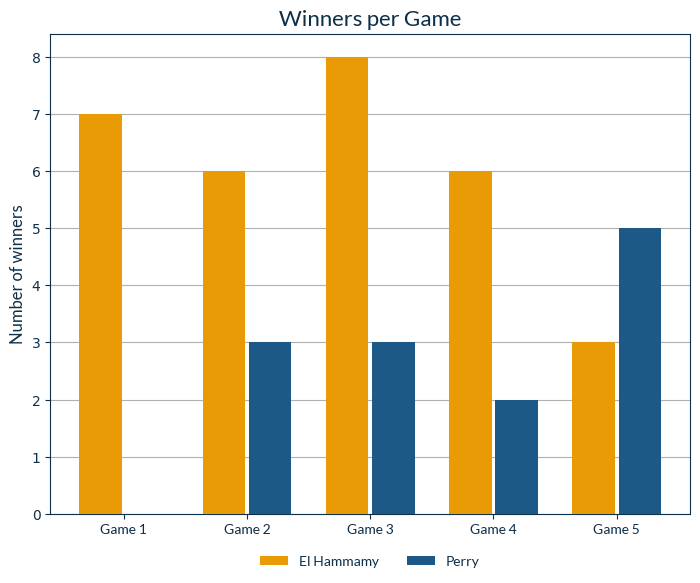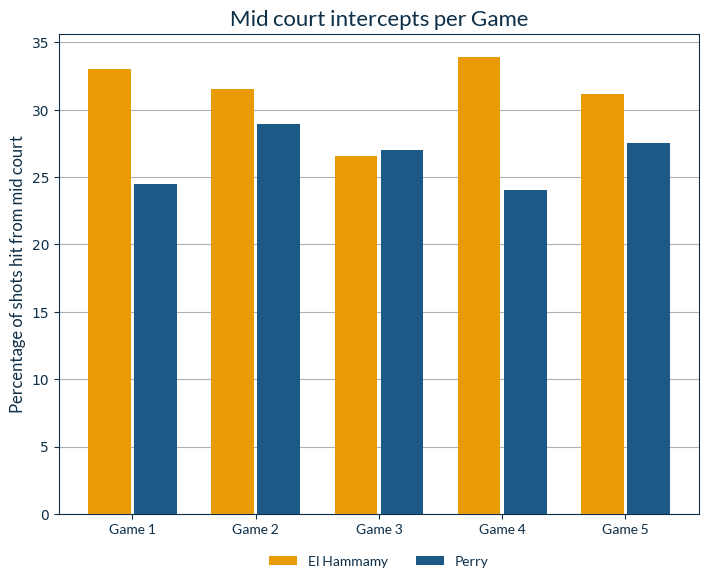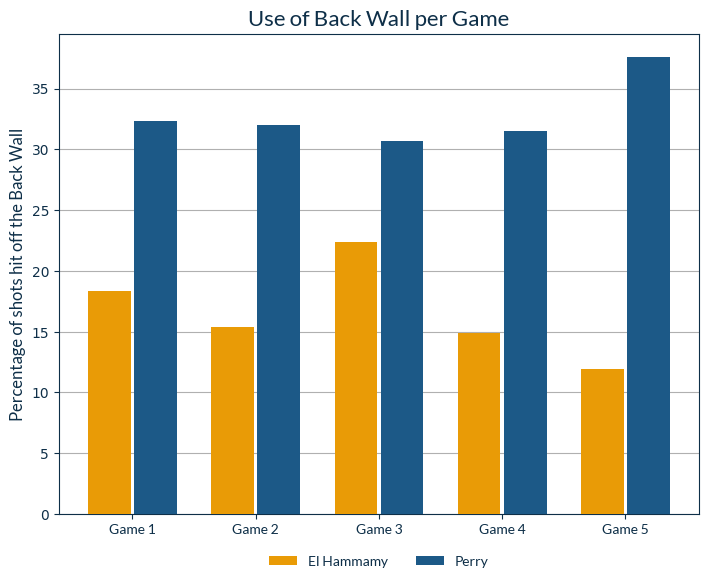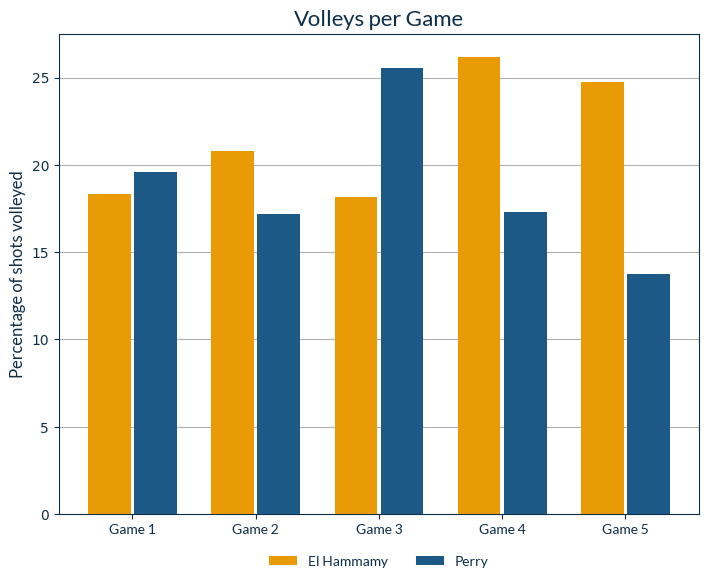Blog: Perry vs Hammamy Black Ball 2020
Today we are featuring another one of my favourite matches, the 2020 Black Ball Open Final between the home favourite Hania El-Hammamy and England’s Sarah-Jane Perry. Hania had won the Platinum event at Black Ball 9 months ago, beating SJ in the semi-final in 5 games, and had dispatched Amanda Sobhy 3-0 in 39 minutes in her semi-final this time around. Meanwhile SJ was coming off a bruising 5th set tiebreak with Joelle King in 74 minutes where all 3 of her games won were 13-11. On top of this she had battled through a 3-1 with Camille Serme, 3-1 with Joshna Chinappa and 3-2 with Emily Whitlock in her opening round. Everything pointed in Hania’s favour to clinch another PSA World Tour Title, something Perry hadn’t done in over 2 years.
The first game went as many might have expected, with Hania dominating by controlling the T. 1 in 3 of her shots were hit from mid-court compared to one in four for Perry. The game ended 11-4 with all 4 of Perry’s points coming from Hammamy errors. Those errors were probably of little concern to Hammamy given that she was able to hit 7 winners to Perry’s 0, though it was not for lack of Perry trying, as Hania had to retrieve 11% of shots from the front of the court in this game.
Figure 1: Showing the rally length and outcomes for Game 1
Game 2 is closer but again goes the way of Hammamy, 11-9. The differences in play are less stark as Perry manages to get up the court a bit more and hit from mid court 29% of the time compared to Hania’s 32%, though Hania is volleying 1 in 5 shots compared to Perry’s 1 in 6. The difference maker in this game is how often Hania is able to find winners again – 6 compared to Perry’s 3 while both make 3 unforced errors. In addition in these first two games that Hania wins there are 13 rallies of 15 shots or more – of these Hania wins 10, suggesting that lengthening the rallies has worked particularly well for her. SquashTV also make a note of it being an unforgiving court, and of the effectiveness of Hania’s straight drops.
Above - Figure 2 showing the number of winners hit by both players per game, and Figure 3 showing the percentage of shots hit from mid-court by both players per game.
Game 3 sees a small reversal as Perry is able to get in front and hit more from mid-court and volley more often than Hania for the first time (26% to 18%). Despite this there’s one staggering stat that holds for the whole match - how often SJ lets the ball through to the back wall. This potentially comes down to the difference in styles, Hania wants to take time away from Perry using her movement to take the ball early while SJ wants to wait for the ball to sit up off the back wall and use her skill in the swing to create pressure through control and deception. As you can see below across the entire match Perry allows roughly 32% shots to come off the back wall, compared to just 17% for Hania. This increase in volleying pays dividends for Perry as despite a staggering 8 winners for Hammamy in game 3, they are accompanied by 4 errors, allowing Perry to take the third 11-9. Perry has adapted to control the mid court and also reversed the trend of the first two games to win 7 of the 10 longest rallies. Hammamy has still gone for winners while under more pressure and the resulting errors have cost her. Game on.
Above - Figures 4&5 showing the percentage of shots each player allowed to hit the back wall, and the percentage of shots hit on the volley per player per game.
Game 4 is brutal. There are 27 rallies including lets, and 8 of them last 15 or more shots. Perry wins 4, Hammamy 3. Hammamy hits 6 winners and 6 unforced errors while Perry hits 2 of each, the same ratio. This will come down to who plays the big points better. It is neck and neck all the way to 7-7, 8-8, 9-8 Hammamy. Perry hits one of her two errors this game - 10-8 Championship ball. Two good bits of squash get it to 10-10 and Hammamy makes two errors. One is a tough volley off a good lob, the other an attempted flick gone wrong. Twice Hammamy has tinned out on game ball. There is so little between them - one of the few differences is the crowd reception, elated when Hammamy hits a winner, but quiet when Perry does. Hammamy has taken the ball earlier and volleyed more, but lifted more from Perry’s attacking shots. Perry has continued to let the ball hit the back wall more and boasted more. The key difference here is that this game has 5 lets and Hammamy concedes 2 strokes and a no let. Perry concedes nothing through decisions this game; in fact she doesn’t concede a stroke all match. The balance seems to have shifted from the clear Hania in front, SJ behind dynamic from the first two games. They head off at 2-2 in very different places, interestingly with no coach in person thanks to Covid protocol. Perhaps, for the first time, Perry is ahead.
Figure 6 showing the duration and outcome of rallies in game 4.
Game 5 is completely different. Hania knows she has to adapt and makes her first big tactical change of the match. She hits just 2 unforced errors but only hits 3 winners, a sign of a shifted mindset, that she will make Perry will have to earn every point. From being 4-1 down early, this change seems to turn the tide back in her favour again. Rallies 1-6 are all under 10 shots, where Perry gets this lead. 6 of the next 9 are longer than 12 shots, Perry hits 3 unforced errors in a row in this time. Hammamy uses her youth and perhaps lighter legs to win all 6 of those longer rallies, taking her 9-6 up. She has won 8 of the last 10 points. Perry gets hit with her only no-let at 8-6 down after a 28 shot epic rally. Then the game changes again. Third shot of the rally, loose drive, stroke to Perry. Is the moment getting to Hammamy? Up to now she has played with freedom, up to the point of serving out twice. Perry then reels off 3 winners including an audacious cross court hold and flick at 9-9. One more big point, one more game ball and another error from Hammamy. Perry has done what seemed impossible at points. To come back and beat the Egyptian in Egypt, to dethrone the reigning champion.
So what changed to allow Sarah-Jane Perry to reverse the 0-2 deficit and take the win? In game 3 she is able to volley more and hit more from midcourt, forcing errors out of Hammamy, but this reverts back in games 4 and 5. The winner to unforced error ratio has Hania ahead in games 1 and 2, tied in game 4 and SJ ahead in game 5. Trying to reconcile this whole match in one stat is impossible, rather it is a combination of a few factors. SJ does better in the longer rallies in games 3 & 4, as Hania concedes more strokes. Suddenly in the fifth SJ is able to find more winners when Hania adapts to dig in and strengthen in the longer rallies again, up until the nerves hit Hammamy and she makes errors at crucial moments. Part of what I love about squash is that it is as much mental as physical, and that sometimes experience really does pay off.
In addition, this match is a good example that not everything can be neatly tied up with a data driven summary, luck and randomness exist and are part of the beauty of sport. A lot of traditional measures would suggest Hania should have won, she went +12 winners to unforced errors over the match and SJ only went +2. Hania hit more from mid-court and volleyed more in 4 games. Had she won one more point in the fourth game she would have been lauded for her attacking gameplan, instead it might be called into question. Even trying to summarise an individual game can be difficult when both players go on big runs of points, like the 5th game. In the end there is no measure for how ‘big’ a point is or how well someone plays them over a single match, though maybe that is something to investigate in the future over a wider set of matches…
Jesse Mills








